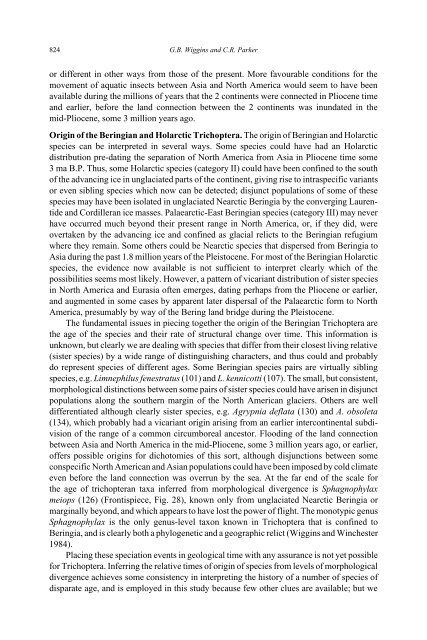Caddisflies of the Yukon - Department of Biological Sciences ...
Caddisflies of the Yukon - Department of Biological Sciences ...
Caddisflies of the Yukon - Department of Biological Sciences ...
Create successful ePaper yourself
Turn your PDF publications into a flip-book with our unique Google optimized e-Paper software.
824 G.B. Wiggins and C.R. Parker<br />
or different in o<strong>the</strong>r ways from those <strong>of</strong> <strong>the</strong> present. More favourable conditions for <strong>the</strong><br />
movement <strong>of</strong> aquatic insects between Asia and North America would seem to have been<br />
available during <strong>the</strong> millions <strong>of</strong> years that <strong>the</strong> 2 continents were connected in Pliocene time<br />
and earlier, before <strong>the</strong> land connection between <strong>the</strong> 2 continents was inundated in <strong>the</strong><br />
mid-Pliocene, some 3 million years ago.<br />
Origin <strong>of</strong> <strong>the</strong> Beringian and Holarctic Trichoptera. The origin <strong>of</strong> Beringian and Holarctic<br />
species can be interpreted in several ways. Some species could have had an Holarctic<br />
distribution pre-dating <strong>the</strong> separation <strong>of</strong> North America from Asia in Pliocene time some<br />
3 ma B.P. Thus, some Holarctic species (category II) could have been confined to <strong>the</strong> south<br />
<strong>of</strong> <strong>the</strong> advancing ice in unglaciated parts <strong>of</strong> <strong>the</strong> continent, giving rise to intraspecific variants<br />
or even sibling species which now can be detected; disjunct populations <strong>of</strong> some <strong>of</strong> <strong>the</strong>se<br />
species may have been isolated in unglaciated Nearctic Beringia by <strong>the</strong> converging Laurentide<br />
and Cordilleran ice masses. Palaearctic-East Beringian species (category III) may never<br />
have occurred much beyond <strong>the</strong>ir present range in North America, or, if <strong>the</strong>y did, were<br />
overtaken by <strong>the</strong> advancing ice and confined as glacial relicts to <strong>the</strong> Beringian refugium<br />
where <strong>the</strong>y remain. Some o<strong>the</strong>rs could be Nearctic species that dispersed from Beringia to<br />
Asia during <strong>the</strong> past 1.8 million years <strong>of</strong> <strong>the</strong> Pleistocene. For most <strong>of</strong> <strong>the</strong> Beringian Holarctic<br />
species, <strong>the</strong> evidence now available is not sufficient to interpret clearly which <strong>of</strong> <strong>the</strong><br />
possibilities seems most likely. However, a pattern <strong>of</strong> vicariant distribution <strong>of</strong> sister species<br />
in North America and Eurasia <strong>of</strong>ten emerges, dating perhaps from <strong>the</strong> Pliocene or earlier,<br />
and augmented in some cases by apparent later dispersal <strong>of</strong> <strong>the</strong> Palaearctic form to North<br />
America, presumably by way <strong>of</strong> <strong>the</strong> Bering land bridge during <strong>the</strong> Pleistocene.<br />
The fundamental issues in piecing toge<strong>the</strong>r <strong>the</strong> origin <strong>of</strong> <strong>the</strong> Beringian Trichoptera are<br />
<strong>the</strong> age <strong>of</strong> <strong>the</strong> species and <strong>the</strong>ir rate <strong>of</strong> structural change over time. This information is<br />
unknown, but clearly we are dealing with species that differ from <strong>the</strong>ir closest living relative<br />
(sister species) by a wide range <strong>of</strong> distinguishing characters, and thus could and probably<br />
do represent species <strong>of</strong> different ages. Some Beringian species pairs are virtually sibling<br />
species, e.g. Limnephilus fenestratus (101) and L. kennicotti (107). The small, but consistent,<br />
morphological distinctions between some pairs <strong>of</strong> sister species could have arisen in disjunct<br />
populations along <strong>the</strong> sou<strong>the</strong>rn margin <strong>of</strong> <strong>the</strong> North American glaciers. O<strong>the</strong>rs are well<br />
differentiated although clearly sister species, e.g. Agrypnia deflata (130) and A. obsoleta<br />
(134), which probably had a vicariant origin arising from an earlier intercontinental subdivision<br />
<strong>of</strong> <strong>the</strong> range <strong>of</strong> a common circumboreal ancestor. Flooding <strong>of</strong> <strong>the</strong> land connection<br />
between Asia and North America in <strong>the</strong> mid-Pliocene, some 3 million years ago, or earlier,<br />
<strong>of</strong>fers possible origins for dichotomies <strong>of</strong> this sort, although disjunctions between some<br />
conspecific North American and Asian populations could have been imposed by cold climate<br />
even before <strong>the</strong> land connection was overrun by <strong>the</strong> sea. At <strong>the</strong> far end <strong>of</strong> <strong>the</strong> scale for<br />
<strong>the</strong> age <strong>of</strong> trichopteran taxa inferred from morphological divergence is Sphagnophylax<br />
meiops (126) (Frontispiece, Fig. 28), known only from unglaciated Nearctic Beringia or<br />
marginally beyond, and which appears to have lost <strong>the</strong> power <strong>of</strong> flight. The monotypic genus<br />
Sphagnophylax is <strong>the</strong> only genus-level taxon known in Trichoptera that is confined to<br />
Beringia, and is clearly both a phylogenetic and a geographic relict (Wiggins and Winchester<br />
1984).<br />
Placing <strong>the</strong>se speciation events in geological time with any assurance is not yet possible<br />
for Trichoptera. Inferring <strong>the</strong> relative times <strong>of</strong> origin <strong>of</strong> species from levels <strong>of</strong> morphological<br />
divergence achieves some consistency in interpreting <strong>the</strong> history <strong>of</strong> a number <strong>of</strong> species <strong>of</strong><br />
disparate age, and is employed in this study because few o<strong>the</strong>r clues are available; but we
















